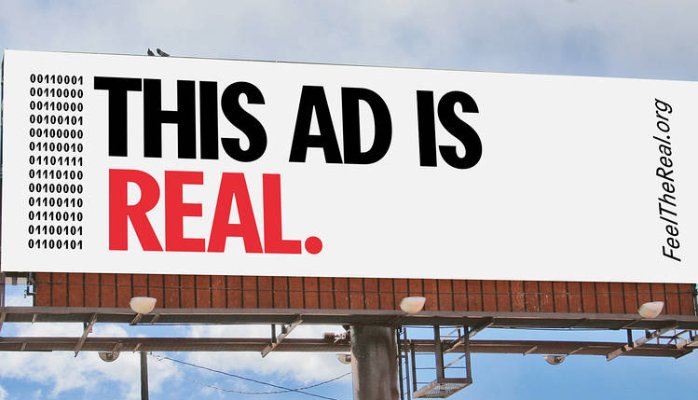Wrapify has been an enthusiastic fan of the Outdoor Advertising Association of America’s (OAAA) “Feel the Real” advertising campaign since its launch last September — how could we not be?
With 1,400 creative executions across 20 media markets, “Feel the Real” was smart, fun, put the association’s money where its mouth is, and dovetailed with Wrapify’s central premise: that advertising you can physically see in the real world is more reliable and effective than the majority of digital marketing.
So we were extremely satisfied to read the OAAA white paper released this week, validating pretty much every point about the strength of out-of-home advertising, as well as revealing the half-mirage that is digital advertising.
The purpose of the “Feel the Real” campaign was two-fold: prove that outdoor advertising effectively influences the people who see it, and show how digital advertising results are often “gamed” by bot-views, questionable and near-hidden ad placements and other deceptions.
For the first part of the equation, “Feel the Real” targeted people who work in advertising, during Advertising Week. The campaign launched with big, stark, loud black-and-white-and red billboards, posters and bus ads (no car wraps though, unfortunately, LOL), proclaiming “This Ad is Real,” and other similar messages.
The targeting was both general and cheekily specific — posters near FCB, Havas, OMD, Mindshare and other offices literally read “Hey FCB, This Ad is Real,” for example (depending on the agency near the signage, obvs). A few even called out specific ad agency influencers by name — Ogilvy’s Lauren Crampsie, we’re looking at YOU! (and your 150K Twitter followers) — asking for promotional tweets in return. Of course they got ‘em!
One consistent across all the campaign’s outdoor ads was to direct people who saw them to FeelTheReal.org. Nearly 30,000 unique visitors checked out the site — an amazing number for a campaign targeting a narrow B2B category of professionals — during the seven-week campaign, with clear correlation to the 20 markets where the ads ran, and engaging visitors for more than two minutes a visit!
We won’t go into all the details — there’s a small separate sideline integrating a printed binary code that when deciphered ties in with the FX series “Mr. Robot,” for one fun sideline — because we hope you’ll to read the OAAA white paper. But we will talk for a minute about the digital side of the campaign, which was both ingenious and a bit sneaky.
As a counterpoint to the “real,” the OAAA also engaged web traffic brokers who promised they could deliver more “targeted” traffic in a week than the OAAA had earned in seven weeks, while promising to do it for $250 or less. A bargain in the making at outdoor advertising’s expense, right?
Nope. Not even close.
To test, the OAAA created three mirror sites — FeelTheUnreal.org; FeelTheFake.org; FeelTheBots.org — and bought three tranches of traffic from three of the highest reviewed traffic brokers (who shall remain nameless).
The web traffic brokers’ results are, shall we say, unsettling. The mirror sites got a lot of traffic, but little to zero engagement. One broker’s outreach brought a “targeted audience” that lasted exactly 18 seconds. For Every. Single. Visitor. Think they were “real”?
Another got 50,000 visitors, exactly one of whom took the survey on the site. We think that one person actually was probably (without the “air-quotes”) real.
Again, there’s a lot more information to share about the bots, ghosts, and invisible nobodies who swarmed the fake OAAA sites, but we’d rather you check out the whole white paper because it’s loaded with worthwhile information and a hoot to read to boot — just to take one headline as an example: “If a bot clicks a non-viewable ad, does the ad blocker hear it?”
But of all the impressive analytics in the white paper, perhaps the most relevant figure is one that’s already been widely reported in Forbes, Adweek and elsewhere: More than $7 billion of digital advertising is completely wasted on ads that nobody sees.
And that’s why “Real” matters. That’s why Out-of-Home matters now, arguably more than ever. And that’s why Wrapify is revolutionizing the outdoor market.
Wrapify doesn’t dismiss digital or technology…but we don’t worship at its altar simply for technology’s sake, either. Wrapify uses digital technology to make something that’s proven to work even better.
It’s why places like Business Insider and Tech Crunch have called Wrapify “The Uber for advertisers.”
We’ve taken the proven old-school idea of wrapped vehicles, added crowdsourcing, the sharing economy, proprietary technology, and analytics, to create a genuinely disruptive outdoor advertising platform that’s proving to be a winner for brands, drivers, and the marketing experience.
Drivers get paid regularly by the mile through a unique mobile application that tracks their movements. Brands like eBay, Harrah’s and Petco get real-time visualized dashboards of cars’ impressions, so they know how many people are seeing their messaging.
Wrapify’s got case studies and numbers to back up our success just as much as the OAAA’s white paper does for “Feel the Real.” But we wanted to make this more about them than us, so we’ll just leave it at that. Hopefully you won’t 🙂
